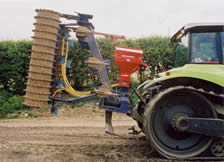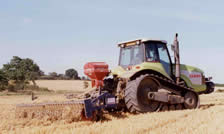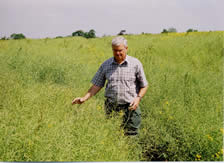SWITCH TO LOW COST RAPE ESTABLISHMENT PROVES SUCCFUL AT BARTLOW ESTATES.
Rethinking their method of oil seed rape establishment with the introduction of a single pass, one-man system has brought some major benefits at Bartlow Estate, Cambridgeshire.
Together with cereals and sugar beet, some 800 acres of rape are a major crop on this 4000-acre, all-arable enterprise.
Until recently, a conventional approach was taken to drilling the rape with a variety of seedbed preparation techniques. These could involve up to five different operations: ploughing, pressing, power harrowing, drilling and rolling.
"The usual and inevitable loss of moisture resulted in late and less than optimum establishment," said estate manager John Goodchild.

It was also a time consuming process, tied up men and machinery and was expensive.
However, last year Mr Goodchild saw a different approach in action on a Northants farm and was impressed. "The Northants rape seemed more advanced than ours and a good crop had been established," he recalls.
Last harvest, Bartlow Estate introduced a similar system: an OPICO Air 8 pneumatic seeder with electric drive fan mounted on a Tim Howard Engineering seven-leg subsoiler with seven legs at 50cm spacing and a toothed packer roller. The combination has an operating width of 4.2 metres, folds to 3  metres for transport and is used behind a Claas Challenger 55 tractor.
metres for transport and is used behind a Claas Challenger 55 tractor.
Working directly behind the combine, on stubble and chopped straw, the system proved effective. "The main motive was to reduce the time and cost of establishing the rape and to make a better job of it," said Mr Goodchild, "and we achieved that."
Bottleneck cured
Another virtue of the single pass, one man operation is that it has cured the post-harvest bottleneck. "It has released men and machines that used to be involved with rape establishment for preparing land for cereals, which has brought us forward," said Mr Goodchild.
Operating at about 6mph and at a depth of 9 inches to relieve the combine wheelings, the rig has a daily capacity of about 65 acres with just one man. "You need a reasonable turn of speed to create turbulence around the back of the leg into which the seed drops", says Mr Goodchild.
Seed is applied at 8-10kg per ha which, says Mr Goodchild, "is fine with home saved seed but a bit expensive with the bought in product." Slug pellets are incorporated with the seed using an electric cement mixer to achieve an even mixture.
"One of the attractions of the system is that it clears some of the straw out of the way and brings up moist soil," added Mr Goodchild. "This affords an ideal environment for the seed to germinate.

"Over the wet winter we've had, it's given good drainage. The crops looked a good colour all through the winter and the roots go straight down the subsoiler slots which is an advantage."
"When we have used discs in the past, our heavy boulder clay could turn into paddy fields in a wet winter," added estate foreman David Hannah. "There's a bottom in the disc system but not in the new system. There's plenty of drainage for the water to get away."
Timing critical
With oil seed rape establishment, timing is critical. "We start combining out wheats about the 8th of August and hopefully get harvest wrapped up by early September," said Mr Goodchild. "Rape sowing starts in the middle of August, following winter wheat, and we aim to finish by the end of the month. You don't want to be running too far into September."
After sowing the land is Cambridge rolled, but this year Mr Goodchild feels that more consolidation would be an advantage and plans to use a Simba double furrow-press.
The new outfit works at a shallow angle across the previous year's tramlines enabling them to be loosened up and then used again. This can result in a bit of a bumpy ride when spraying and spreading fertiliser. But as the rig's operator Tony Oakley is quick to point out, "you notice it the first couple of times but as you gradually go over it more with the sprayer it evens itself out."
While this particular system works well for Bartlow Estate, there are other options. "We chose to go with this subsoiler route to take out the wheelings and relieve surface compaction," says John Goodchild. "But is you just want to go with a set of discs and drop the rape seed behind that, or drop it in front of a press, the rape will still establish.
"If you've got sufficient moisture and a bit of soil around the seed,
rape will grow."